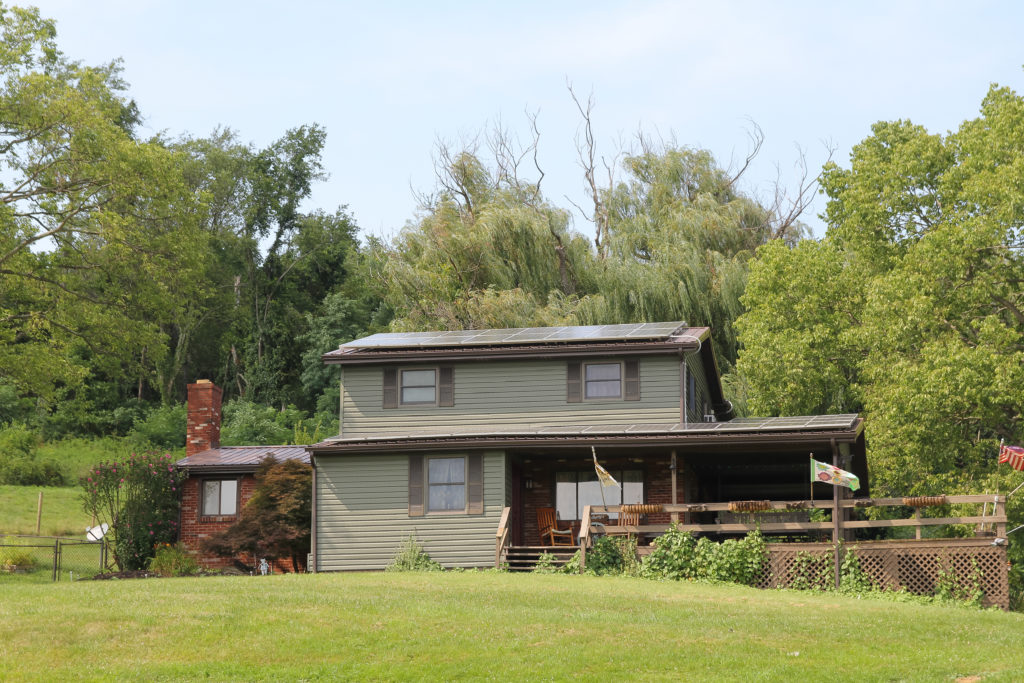This is the fourth blog in our Examining Climate series, where CCJ staff members and others will be sharing their favorite (or least favorite) climate solution, looking at the benefits and the costs in the hope of sparking an honest conversation about how we address the climate crisis and keep our focus on environmental justice. This blog was written by Organizing Director Heaven Sensky.

When I first joined team CCJ back in 2019, I was tasked with supporting local community members in holding a Solar Festival in Greene County, the heart of Coal Country. Residents wanted to introduce the efficacy of solar power to their communities, where celebrating and investing in coal mining and energy production had dominated community narratives for generations. In planning the Solar Festival, I learned a whole lot about solar power, and I also learned a whole lot about the misconceptions of solar power across our communities.
We found that many folks didn’t know that solar power was something that could be used efficiently in our dreary, often cloud-covered corner of Southwestern Pennsylvania. Many residents also didn’t view going solar as something that would ever be financially available to them. In addition to that, it was unclear to many people how valuable diversifying our energy sources is to the efficacy of our energy grid.
Through all of this, I supported my grandparents in going solar on their 50-acre farm in Eighty- Four, Pennsylvania (see picture above). We were all skeptical of the efficacy of going solar. My grandparents decided to use their check from a natural gas gathering pipeline installation to install 50 solar panels on the roof of their home. Our family farm does not have any access to natural gas, and so much of their energy came from the electrical grid. Since then, even in the winter months, my grandparents have paid $0 in electric bills, and they have received money back via SRECs (solar renewable energy certificates) from the state and via the sale of excess solar energy to the power company. Through this process, I learned that solar power is very viable, and I am even looking to go solar myself where I live, on my grandparents’ farm.
Below I will share important information about the efficacy of solar and the financial benefit of going solar. You will also learn about some of the negative environmental impacts of solar energy production and what leaders in renewable energy are doing to help mitigate those negative impacts.
How does solar work?
The amount of sunlight that strikes the earth’s surface in an hour and a half is enough to generate the energy needs of the entire world for a full year. Solar radiation is light – also known as electromagnetic radiation – that is emitted by the sun. Solar technologies capture this radiation and turn it into useful forms of energy. (Energy.gov)
Solar technologies convert sunlight into electrical energy either through photovoltaic (PV) panels or through concentrating solar-thermal power (CSP). This energy can be used to generate electricity, which is then sent back through the grid via traditional power links or stored in batteries or thermal storage. (Energy.gov) We are most familiar with photovoltaic solar energy technology, which is used in solar panels. When the sun shines onto a solar panel, energy from the sunlight is absorbed by the PV cells in the panel. This energy creates electrical charges that move in response to an internal electrical field in the cell, causing electricity to flow.
Researchers are working to increase the efficacy of solar cells so that they are able to convert more solar energy into electricity. At this time, despite solar panels working well to produce energy, most of it is lost: The technology has a lot of room to grow and improve.
How much of our grid is powered by solar already?
According to the Pennsylvania Department of Environmental Protection (DEP), solar photovoltaic installations are increasing in the state, but solar currently produces less than 1 percent of our net electricity generation. (DEP) The DEP Energy Programs office is tasked with increasing the solar power in the grid to at least 10% in-state by 2030. Pennsylvania’s commitment to renewable energy is deeply important, as 33% of greenhouse gas emissions in Pennsylvania come from electricity generation. (DEP)
Does solar work in Pennsylvania?
Solar works in all places that the sun shines! As long as the sun shines on your roof, you can go solar. In Pennsylvania, having a south-facing roof is a huge benefit, as is little to no tree coverage. You don’t have to place the panels on your roof either; they can be arranged on your property, as long as there is available space!
Will I save money?
This depends on the amount of electricity you consume. When you get a quote from a solar installer, they will look at your energy usage via your current electric bill. If you are able to accommodate your energy usage with solar power production via your installation, you will likely save money – as long as your solar panel finance option is less than your current cost of electricity! In addition, you will receive compensation from the utility company if you produce more power with your panels than you utilize. Your solar installer will help you determine how much energy your panels will produce on average. You can check the average rate of utility cost via the Utility Rate Database site to learn more about the cost and benefit of energy production and use via solar. The energy efficiency of your home also plays a role in this, and is related to the quality of your windows and insulation as well as the efficiency of your appliances, etc. The more efficient your home, the more efficient your energy usage. Solar panels are generally viewed as upgrades and will likely increase the value of your home.
Most solar installers have finance options. Consumers can also finance solar panels through other options such as home equity or home improvement loans. According to the Department of Energy, new homeowners can add solar as part of their mortgage with loans available through the Federal Housing Administration and Fannie Mae, which allow borrowers to include financing for home improvements in the home’s purchase price. (Energy.gov) Solar financing, like any financing, can be difficult and predatory. The Clean Energy States Alliance released a guide to help homeowners understand their options, explaining the advantages and disadvantages of each. Download the Homeowner’s Guide to Solar Financing here.
In December 2020, Congress passed an extension of the ITC (federal investment tax credit), which provides a 26% tax credit for solar systems installed in 2020-2022, and 22% for systems installed in 2023. This means if you install solar during this time frame, you will be able to utilize 26% of the cost of your solar project as a tax credit, or 22% in 2023. (Energy.gov) The tax credit expires in 2024 unless Congress renews it. Learn more about the ITC here. You can see what additional incentives and tax breaks you may have access to in going solar by visiting the Database of State Incentives for Renewable Energy.
What are the negative impacts of solar?
According to the U.S. Energy Information Administration, the production of solar energy technology is energy intensive. In addition, hazardous materials are used in the production of solar panels and at times in the production of energy in solar power plants. Widespread solar use could also require the use of large amounts of land. Lastly, some solar power plants require the use of water to clean and cool them. In some cases, this may limit the water available for ecosystems and communities.
Despite these negatives, studies conducted by a number of organizations and researchers have concluded that PV systems can produce the equivalent amount of energy that was used to manufacture them within 1 to 4 years. Also, most PV systems have operating lives of up to 30 years or more. (U.S. Energy Information Administration)
The U.S. Department of Energy is supporting various efforts to address end-of-life issues related to solar energy technologies, including the recovery and recycling of the materials used to manufacture PV cells and panels. Several states have enacted laws that encourage recycling of PV panels. (U.S. Energy Information Administration)
Learn more about going solar
You can learn more about going solar by visiting the following resources provided by the Department of Energy Office of Energy Efficiency and Renewable Energy:
Residential Consumer Guide to Solar Power – In an effort to make going solar as effortless and streamlined as possible, the Solar Energy Industries Association developed this guide to inform potential solar customers about the financing options available, contracting terms to be aware of, and other useful tips.
A Homeowner’s Guide to Solar Financing: Leases, Loans and PPAs – This guide from the Clean Energy States Alliance helps homeowners navigate the complex landscape of residential solar system financing. It describes three popular residential solar financing choices and explains the advantages and disadvantages of each, as well as how they compare to a direct cash purchase.
Learn more about how you can help bring solar to communities across Pennsylvania by visiting the Solar United Neighbors website.
You may also want to check out the earlier CCJ blog Why Solar has a Bright Future in PA.
Is solar power one of your favorite renewable energy sources? Reach out to us to talk more about your favorite (or least favorite) climate solutions!


We have generated as much electricity as we use at our house for more than 9 years now! We had a solar PV system installed on the roof of our home in WashPa in April 2013.
That’s great, Candy!
Also, thanks for your comment and for reading our blog. 🙂